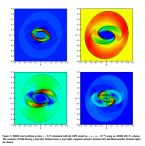
Conferències al DAA. Xarrada a càrrec del Dr. Michael Dumbser, del Laboratory of Applied Mathematics, University of Trento. Lloc: Seminari del Departament d'Astronomia i Astrofísica, 4a planta de l'Edifici d'Investigació, a Burjassot. Dia: dimecres 19 de juliol de 2017. Hora: 10:00.
ABSTRACT:
In this talk, we propose a new unified first order symmetric hyperbolic and thermodynamically compatible theory of Newtonian continuum mechanics coupled with electro-dynamics. The model is able to describe the behavior of moving elasto-plastic dielectric solids as well as viscous and inviscid fluids in the presence of electro-magnetic fields. It is actually a very peculiar feature of the proposed PDE system that viscous fluids are treated just as a special case of elasto-plastic solids. This is achieved by introducing a strain relaxation mechanism in the evolution equations of the distortion tensor A, which in the case of purely elastic solids maps the current configuration to the reference configuration. The model also contains a hyperbolic formulation of heat conduction as well as a dissipative source term in the evolution equations for the electric field given by Ohm's law. Via formal asymptotic analysis we show that in the stiff limit, the governing first order hyperbolic PDE system with relaxation source terms tends asymptotically to the well-known viscous and resistive magnetohydrodynamics (MHD) equations, and to the compressible Navier-Stokes equations in the absence of electro-magnetic fields. The present work extends the unified first order hyperbolic model of Newtonian continuum mechanics recently proposed by Peshkov and Romenski (2016) to the more general case where the continuum is coupled with electro-magnetic fields. The governing PDE system is symmetric hyperbolic and satisfies the first and second principle of thermodynamics, hence it belongs to the so-called class of symmetric hyperbolic thermodynamically compatible systems (HTC), which have been studied for the first time by Godunov in 1961 and later in a series of papers by Godunov and Romenski. An important feature of the proposed model is that the propagation speeds of all physical processes, including dissipative processes, are finite. The model is discretized using high order accurate ADER discontinuous Galerkin (DG) finite element schemes with a posteriori subcell finite volume limiters and using high order ADER-WENO finite volume schemes. We show numerical test problems that explore a rather large parameter space of the model ranging from compressible Euler and Navier-Stokes flows over ideal MHD, viscous and resistive MHD to pure electro-dynamics and moving dielectric elastic solids in a magnetic field. We will also show applications of our ADER-DG framework to the ideal and resistive relativistic MHD equations.
Imatges:
















